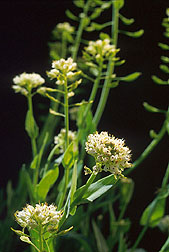This page has been archived and is being provided for reference purposes only. The page is no longer being updated, and therefore, links on the page may be invalid.
|
For more details of this research, read Agricultural Research. |
"Green Technology" Helps Clean Up Toxic SoilsBy Hank BeckerJune 19, 2000 When it comes to cleaning up soils contaminated with heavy and toxic metals, Mother Nature has Agricultural Research Service plant physiologist Leon V. Kochian to thank. Thirteen years of research at the U.S. Plant, Soil and Nutrition Laboratory at Ithaca, N.Y., makes Kochian an authority on how certain plants take up essential mineral nutrients and toxic heavy metals--like zinc, cadmium and nickel--from soils. He has also characterized strategies some plants use to withstand toxic soils. Kochian's pioneering research shows how plant species grow on marginal and toxic-metal-laden soils. He's an international expert on plant responses to environmental stress, plant mineral nutrition, and how they clean up soils contaminated with heavy metals and radioisotopes. Contaminated soil and water pose major environmental, agricultural and human health problems that may be partially solved by a new technology called phytoremediation. It uses green plants to remove pollutants or render them harmless. Current engineering-based technologies--such as transporting contaminated topsoil to landfills--are costly and dramatically disturb the landscape. Kochian's "green technology" is a cost-effective, plant-based approach. It uses certain plant species-- known as metal hyperaccumulators--to "vacuum up" heavy metals through their roots and store them in above-ground plant tissue. Once concentrated in the easily harvested plant stems and leaves, these elements can be stored for later use. Kochian is clarifying how the complex trait of metal hyperaccumulation involves several different transport and tolerance mechanisms within the plant. He's working with plants like Thlaspi caerulescens, which thrives on soils contaminated with high levels of zinc and cadmium, and Amaranthus retroflexus, which removes up to 40 times more radiocesium from soil than other plant species tested. For more details of this research, see the June issue of Agricultural Research. ARS is USDA's chief research agency. Scientific contact: Leon V. Kochian, ARS Plant, Soil and Nutrition Laboratory, Ithaca, N.Y.; phone (607) 255-2454, fax (607) 255-2459, lvk1@cornell.edu. |

